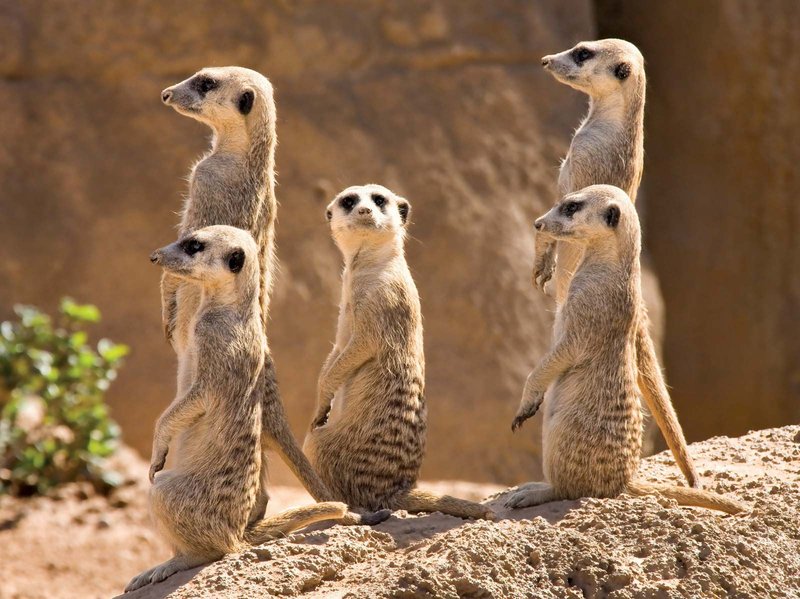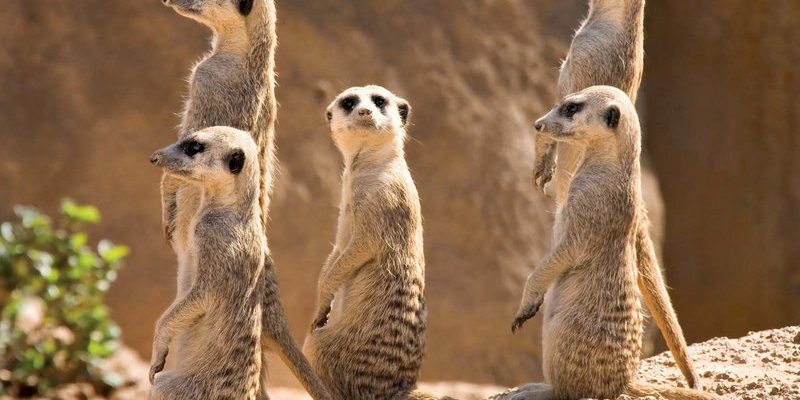
It’s like attending a party where everyone has their own unique vibe but shares common interests. In this article, we’ll dive into ten fascinating animals that resemble meerkats in some way, be it their appearance, behavior, or habitat. You might even discover a new favorite animal or two along the way. So, grab your cup of coffee, sit back, and let’s explore these creatures together!
1. Suricates
You might be surprised to learn that “meerkat” is actually a type of suricate. Yes, they’re the same species, but the term “meerkat” is often used to refer to the social aspects of these animals. Suricates are small, diurnal mammals that are part of the mongoose family. They live in groups, called mobs, and are known for their remarkable social structures.
One way to distinguish between meerkats and other animals is by their remarkable social behavior. Suricates display a fun mix of teamwork and lookout systems. While one or two members stand watch, the others forage for food. It’s like a small neighborhood watch, but for critters!
Here’s the thing: if you ever see a group of these little guys standing up, looking around, it’s likely a group of suricates, gathering intel on what’s happening in the wild.
2. Dwarf Mongoose
Next up, we have the dwarf mongoose. These tiny, energetic creatures are about the same size as a meerkat, and they share similar habitats in sub-Saharan Africa. Dwarf mongooses are also social animals, living in groups that can consist of up to 12 individuals.
What sets them apart? While meerkats are primarily herbivores and eat insects, dwarf mongooses are more opportunistic eaters. They’ll munch on insects, small reptiles, and sometimes even fruits. Imagine being at a buffet where you can choose between crunchy critters or a sweet fruit salad!
Dwarf mongooses are also a bit more playful than meerkats and love to engage in roughhousing. If you catch them darting around and wrestling, you might be looking at a dwarf mongoose family!
3. Yellow Mongoose
The yellow mongoose is another close relative to the meerkat, known for its bright yellowish coat. These cute critters are especially common in southern Africa. Like meerkats, they thrive in open habitats like grasslands and savannas.
One major difference is their behavior. Yellow mongooses tend to be a bit more solitary. They are often seen foraging alone or in small family groups rather than the large mobs typical of meerkats. If you’re watching a little yellow guy wandering off on its own, it’s likely a yellow mongoose, soaking up some sunshine while looking for a snack.
You might wonder about their diet; yellow mongooses enjoy a variety of insects and smaller animals, making them opportunistic feeders, much like their meerkat cousins.
4. Tails of the Mongoose
Another fascinating creature is the banded mongoose. This animal also belongs to the mongoose family and is found in eastern and southern Africa. They have a striking appearance with dark stripes running across their backs, making them quite recognizable.
What makes them different from meerkats? Banded mongooses often dig burrows for their homes, just like meerkats. However, their social structures can be more fluid. Groups can change, with individuals joining and leaving more frequently. It’s sort of a laid-back communal vibe.
While they engage in cooperative behaviors, such as babysitting each other’s young, their cooperation levels can vary depending on environmental conditions. This flexibility is one of the many ways banded mongooses keep their existence dynamic!
5. African Wild Dog
Now, let’s transition to a completely different realm with the African wild dog. While they’re larger and quite different in stature, both animals exhibit remarkable social behaviors. African wild dogs hunt in packs and display an almost remarkable level of teamwork reminiscent of meerkats.
So, how do you spot the difference? Size is the most obvious distinction. African wild dogs are much larger, with a build more akin to canines. They have large, rounded ears and distinctive, patchy fur patterns. If you see a group of these dogs darting across the savanna, you’ll know they’re in search of their next meal, unlike meerkats that are scanning for predators.
Their social structures are a delight to watch as they communicate energetically and work together in packs. It’s like watching a well-rehearsed dance unfold in nature!
6. Prairie Dog
Let’s head over to North America for a moment. The prairie dog is a burrowing rodent that shares a few similarities with meerkats. They live in vast colonies called coteries, where they communicate via a series of barks and calls.
What sets them apart? Prairie dogs are more closely related to rodents than to mongoose species. They also have a different diet that consists mainly of grasses and herbs. If you catch a prairie dog popping its head out of a burrow, it might have some grass in its mouth!
Their social behaviors are fascinating too. They have a complex system of communication that helps them alert each other to dangers like predators, much like meerkats, but they do it in their unique prairie dog way.
7. Ground Squirrel
The ground squirrel is another critter that resonates with meerkats. Found primarily in North America, ground squirrels share similar foraging habits and living conditions. They are also known to be social creatures, often seen in groups.
However, ground squirrels can differ in that they usually have a more solitary lifestyle compared to their meerkat counterparts. If you see one standing upright, looking around, it’s probably a ground squirrel keeping an eye out for hawks or other predators.
When they dig burrows, they often use them for hibernation, which is different from meerkats that are active year-round. Ground squirrels are often playful, and their antics can be entertaining to watch!
8. Chipmunks
You might think of chipmunks as small, adorable furballs, and while they might not look like meerkats on the surface, they share some traits. Chipmunks are known for their cheek pouches, which they use to store food.
Though they don’t live in social groups as meerkats do, they are active foragers that sometimes communicate with each other through chirps and whistles. If you catch one darting up a tree with something stashed in its cheeks, it might just remind you of a meerkat’s hustle to gather food.
Chipmunks also dig burrows, but unlike meerkats, their burrows are often solitary homes meant for protection and food storage rather than a communal living space.
9. Coati
The coati, a member of the raccoon family, could be described as a distant cousin to the meerkat. These animals are often found in Central and South America and are known for their elongated snouts and bushy tails.
What’s fascinating is their social structure. Coatis live in groups called bands, similar to meerkats, but they’re much bigger and often have a more hierarchical structure. If you observe them, you might notice them climbing trees and foraging together, always keeping an eye out for danger.
While coatis eat fruits, insects, and small vertebrates, their diet is quite different from the meerkat’s. Watching a group of coatis interact in the wild can be like watching a small family reunion, filled with playful antics and social bonding.
10. Ring-Tailed Lemur
Last but not least, let’s chat about the ring-tailed lemur. Found only in Madagascar, these creatures are known for their striking black-and-white striped tails and social behavior. They spend a lot of time in trees and have a remarkable level of communication within their groups.
Unlike meerkats, who primarily stay close to the ground, ring-tailed lemurs are arboreal, spending their days leaping from branch to branch. If you see a group lounging in the sunlight, it’s likely a ring-tailed lemur family soaking up the rays.
Both species exhibit strong social bonds, but their environments and behaviors are significantly different. Watching lemurs interact can be a delightful educational experience, showing how different species can express their social natures.
In conclusion, the animal world is filled with fascinating creatures that share traits with the charming meerkat. Whether they look similar or exhibit social behaviors that resonate, each one adds a unique flavor to the tapestry of wildlife. So next time you think of meerkats, remember the rich diversity out there and how many cousins they have in the animal kingdom!

